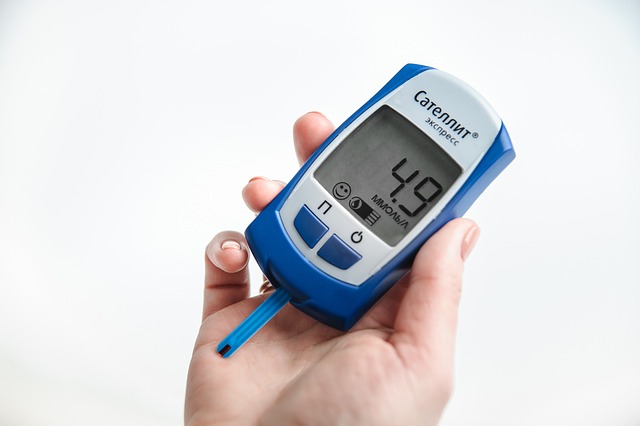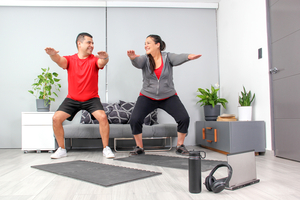When you have prediabetes, also known as borderline diabetes, your blood sugar levels are higher than normal, putting you at risk for developing type 2 diabetes and other serious conditions like heart disease or stroke.[1] Luckily, there's a lot you can do to manage prediabetes and even reverse it. One of the most important steps to take is to get your body moving more and to become more active. According to the CDC, lifestyle changes like losing weight and adding more physical activity such as stretching to your regular routine can help you reduce your risk of developing diabetes by almost 60%.[1]
If you have prediabetes, engaging in any kind of physical movement on a regular basis is important – including stretching. Stretching is a wonderful practice to add to your daily routine to help you stay flexible, get more active, and support your health goals.
Benefits Of Stretching If You Have Prediabetes
Most people recognize aerobic exercise as an important component of a healthy lifestyle. But many people often underestimate the power of stretching to support their muscles, their body, and their overall health.
Here are some of the benefits of stretching for people with prediabetes:
- It keeps your muscles flexible, strong, and healthy.
- Helps you maintain a healthy range of motion in your joints.
- It helps to prepare your muscles for activity, so that you don't strain them or damage them when you try to do certain movements or activities.
- Increases blood flow to your muscles.
- Improves your physical performance when you engage in physical activities.[2,3]
Without stretching, we may have a harder time staying active and we may be more likely to get injuries, strains, pain, or tension.[2]
Remember, staying active is essential if you have prediabetes. Being physically active less than three times per week is one of the major risk factors for developing type 2 diabetes.[4]
Ultimately, stretching allows us to be flexible and limber, enabling us to carry out our daily tasks with more ease and helping us to engage in other fitness activities that support our health goals.
Can Stretching Help Prevent Diabetes?
It is well known that engaging in regular physical activity is one of the best things you can do to prevent diabetes if you are at risk for it. But can stretching exercises in particular reduce your diabetes risk?
Small studies in people with type 2 diabetes and in people who are at risk for type 2 diabetes have shown that stretching your muscles can have positive effects on blood sugar levels.[5,6,7]
Recent research in the Journal of Physiotherapy also found that stretching can help to improve blood flow and artery health, leading the researchers to conclude that stretching could be beneficial in reducing risk of conditions related to vascular problems like heart disease and diabetes.[8]
But before any firm conclusions can be drawn about the benefits of stretching on blood sugars or diabetes risk, more research is needed; many of these studies were very small so the evidence is quite limited.
10 Stretches To Do Every Day With Prediabetes
If you want to get started with a stretching routine to support your muscles, your body, and your health, then all it takes is a few minutes per day.
Try out these 10 easy stretches that work on the major muscle groups:
1. Cat Cow
For the cat cow stretch, start on all fours with your hands and knees planted firmly on the ground. Your wrists should be underneath your shoulders and your knees should be underneath your hips. As you inhale, drop your belly down, turn your gaze up, and tilt your pelvis so your tailbone sticks up. Your back should be arched. This part is called "cow."
As you exhale, tuck your tailbone, tuck your chin to your chest, and round your spine as you lift it to the ceiling. This part is called "cat." Hold each pose for a few moments, and cycle between the two poses for a few minutes as you breathe in and out.

2. Child's Pose
To perform child's pose, start seated on your knees. Spread your knees apart, keeping your big toes touching. As you exhale, lower your torso towards your thighs. Rest your forehead on the floor, and reach your arms out in front of you. Hold for at least 30 seconds, then release.

3. Calf Stretch
Stand at arm's length from a wall, chair, or something sturdy, and reach your arms out to stabilize yourself. Step back with your right foot, then press your right heel into the floor, keeping your left leg bent. Hold, then repeat on the other side.

4. Neck Stretch
Tilt your head to the right, looking slightly downwards at the same time. Place your right arm on the top of your head and gently pull down, bringing your ear close to your shoulder. Hold, then repeat on the other side.

5. Quadriceps Stretch
Stand near a wall or something sturdy that you can hold onto for support. Balancing on your left leg, hold your right ankle behind you with your right arm. Gently pull your heel into your buttocks. Your knees should stay close together, and you should feel a stretch in the front of your thigh. Hold, then repeat on the other side.

6. Hamstring Stretch
Find a table, chair, bed, or other object between knee and waist height. Stand upright, then place your right leg on the object with your foot flexed and your toes pointing up. Bend forward at your waist, reaching towards your right leg. Bend until you feel a stretch in the back of your thigh. Hold, then repeat with the left leg.

7. Shoulder Stretch
Stand up tall, then reach your right arm across your chest so that it is reaching to the left. Use your left arm to pull your arm across your body, so that you feel a good stretch in your right shoulder. Hold, then repeat on the left side.

8. Arm and Shoulder Stretch With Towel
Roll up a towel. Hold the towel behind your back with both hands, with your left hand on the bottom near your waist and the right hand on the top near your head. Pull the towel toward the sky with your right hand, so that your left hand begins to slide up your back. You should feel a stretch in your left shoulder. Hold, then switch hands and repeat.

9. Wrist Stretch In Prayer Position
Place your palms together in front of your face, and bring your elbows together so that they are touching. Slowly, release your elbows and lower your hands towards your waist, keeping your palms pressed tightly together. Hold while you feel your wrists stretching, and then release.

10. Lower Back/Hips Stretch
Lie on the floor on your back, with your knees bent and feet placed firmly on the ground. Throughout this stretch, keep both shoulders on the floor at all times. Keeping your knees together, gently lower your legs to the right side of your body, keeping your shoulders in place. Lower as far as you can, holding the stretch for about 30 seconds. Then repeat on the other side.

For more guidance on these stretches and others, check out resources like Mayo Clinic's Guide to Stretches or Harvard Medical School's Everyday Stretching.
Tips
To get the most out of your stretching routine (and avoid doing more harm than good), keep in mind these important tips:
- Don't force it. Stretching should be mildly uncomfortable, but not painful.
- Stay consistent. Try to stretch every day, or at least several times per week.
- Be patient. Getting flexible takes time, so stick with it. Results will come if you keep working.
- Go for symmetry. Do your stretches on both sides to maintain balance in the body.
- Don't bounce. This can cause injury or damage.
- Warm up beforehand. Don't use stretching to warm up, but rather stretch after your muscles are already warm.[2,3]
Conclusion
Stretching is a wonderful daily practice that helps keep your muscles long, lean, healthy, and flexible. If you stretch regularly, you'll find that you will have less tension in your body, more range of motion, and more ease when performing everyday tasks or physical activities.
This is especially important for people with prediabetes, as staying active and moving your body as much as you can will significantly reduce your diabetes risk and help you to restore your health.
And beyond the physical benefits, stretching can become a nourishing self-care routine that helps you slow down, tune in with your body, and take a few minutes for yourself.
Get started with a stretching routine today – all it takes is 5-10 minutes per day to notice a difference!
References
- What is Prediabetes? Centers for Disease Control and Prevention. Reviewed June 11 2020. https://www.cdc.gov/diabetes/basics/prediabetes.html.
- Harvard Health Letter. The Importance of Stretching. Harvard Medical School. Updated September 25 2019. https://www.health.harvard.edu/staying-healthy/the-importance-of-stretching.
- Stretching: Focus on Flexibility. Mayo Clinic. January 31 2020. https://www.mayoclinic.org/healthy-lifestyle/fitness/in-depth/stretching/art-20047931.
- Diabetes Risk Factors. Centers for Disease Control and Prevention. Reviewed March 24 2020. https://www.cdc.gov/diabetes/basics/risk-factors.html.
- Nelson AG, Kokkonen J, Arnall DA. Twenty minutes of passive stretching lowers glucose levels in an at-risk population: an experimental study. J Physiother. 2011;57(3):173-8.
- Park SH. Effects of passive static stretching on blood glucose levels in patients with type 2 diabetes mellitus. J Phys Ther Sci. 2015 May;27(5):1463-5.
- Gurudut P, Rajan AP. Immediate effect of passive static stretching versus resistance exercises on postprandial blood sugar levels in type 2 diabetes mellitus: a randomized clinical trial. J Exerc Rehabil. 2017 Oct 30;13(5):581-587.
- Bisconti AV, Cè E, Longo S, et al. Evidence for improved systemic and local vascular function after long-term passive static stretching training of the musculoskeletal system. J Physiol. 2020 Sep;598(17):3645-3666.
- Guide to Stretches. Mayo Clinic. February 7 2020. https://www.mayoclinic.org/healthy-lifestyle/fitness/multimedia/stretching/sls-20076840?s=10.
- Everyday Stretching. Harvard Medical School. February 2015. https://www.health.harvard.edu/everyday-stretching.











.webp)






